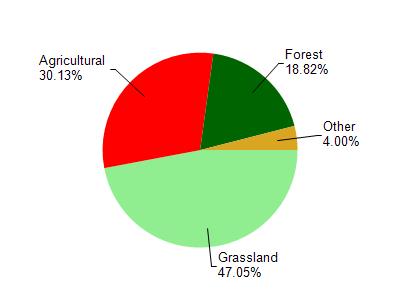Iowa, Lafayette
No
No
No
Fish and Aquatic Life
Overview
Mc Clintock Creek, in the Yellowstone River Watershed, is a 6.93 mile river that falls in Iowa and Lafayette Counties. This river is managed for fishing and swimming and is currently not considered impaired.
Date 2011
Author Aquatic Biologist
Historical Description
McClintock Creek, T3N, R5E, Sections 9-7, Surface acres = 4.7, Miles = 5.8, Gradient = 31.3 feet per mile, Total alkalinity = 289 mg/l, Volume of flow= 3.2 cfs.
McClintock Creek is tributary to the Yellowstone River, entering it about 2.5 miles below Yellowstone Lake. There are some springs entering directly and from feeder streams. It it managed for forage fishes, and suckers are actively fished in early spring. There are four small feeders whose total volume of flow amounts to 15 percent of its base flow. Much of the stream banks are in meadow pasture with some cropland. The remainder of the watershed is covered by cropland and wooded pasture. The lower parts of the stream have a silt bottom while gravel is present in the remainder. Bank erosion varies from moderate to heavy. Waterfowl are limited and muskrats are common. No public land exists in the watershed. The stream is accessible from five road bridges.
From: Piening, Ronald; Poff, Ronald; Threinen, C.W., 1967. Lake and Stream Classification Project. Surface Water Resources of Lafayette County, Wisconsin Department of Natural Resources, Madison, WI.
Date 1967
Author Surface Water Inventory Of Wisconsin
General Condition
Mc Clintock Creek (WBIC 902700) was assessed during the 2018 listing cycle; new biological (fish Index of Biotic Integrity (IBI) scores) and temperature sample data were clearly below the 2018 WisCALM listing thresholds for the Fish and Aquatic Life use. This water was meeting this designated use and was not considered impaired.
Date 2017
Author Ashley Beranek
Condition
Wisconsin has over 84,000 miles of streams, 15,000 lakes and milllions of acres of wetlands. Assessing the condition of this vast amount of water is challenging. The state's water monitoring program uses a media-based, cross-program approach to analyze water condition. An updated monitoring strategy (2015-2020) is now available. Compliance with Clean Water Act fishable, swimmable standards are located in the Executive Summary of Water Condition in 2018. See also the 'monitoring and projects' tab.
Reports
Management Goals
Wisconsin's Water Quality Standards provide qualitative and quantitative goals for waters that are protective of Fishable, Swimmable conditions [Learn more]. Waters that do not meet water quality standards are considered impaired and restoration actions are planned and carried out until the water is once again fishable and swimmable
Management goals can include creation or implementation of a Total Maximum Daily Load analysis, a Nine Key Element Plan, or other restoration work, education and outreach and more. If specific recommendations exist for this water, they will be displayed below online.
Monitoring
Monitoring the condition of a river, stream, or lake includes gathering physical, chemical, biological, and habitat data. Comprehensive studies often gather all these parameters in great detail, while lighter assessment events will involve sampling physical, chemical and biological data such as macroinvertebrates. Aquatic macroinvertebrates and fish communities integrate watershed or catchment condition, providing great insight into overall ecosystem health. Chemical and habitat parameters tell researchers more about human induced problems including contaminated runoff, point source dischargers, or habitat issues that foster or limit the potential of aquatic communities to thrive in a given area. Wisconsin's Water Monitoring Strategy was recenty updated.
Grants and Management Projects
| Project Name (Click for Details) | Year Started |
|---|
|
|
Monitoring Projects
| WBIC | Official Waterbody Name | Station ID | Station Name | Earliest Fieldwork Date | Latest Fieldwork Date | View Station | View Data |
|---|
| 902700 | McClintock Creek | 10046971 | McClintock Creek at CTH N | 1/1/2015 | 10/14/2016 | Map | Data |
| 902700 | McClintock Creek | 10044970 | McClintock Creek at CTH F | 1/1/2015 | 10/14/2016 | Map | Data |
|

Watershed Characteristics
McClintock Creek is located in the Yellowstone River watershed which is 57.46 mi². Land use in the watershed is primarily grassland (47%), agricultural (30.10%) and a mix of forest (18.80%) and other uses (4.00%). This watershed has 158.93 stream miles, 9.53 lake acres and 636.16 wetland acres.
Nonpoint Source Characteristics
This watershed is ranked High for runoff impacts on streams, Medium for runoff impacts on lakes and High for runoff impacts on groundwater and therefore has an overall rank of High. This value can be used in ranking the watershed or individual waterbodies for grant funding under state and county programs.However, all waters are affected by diffuse pollutant sources regardless of initial water quality. Applications for specific runoff projects under state or county grant programs may be pursued. For more information, go to surface water program grants.